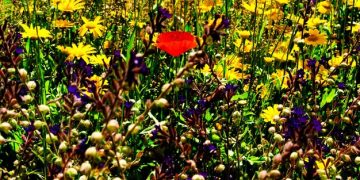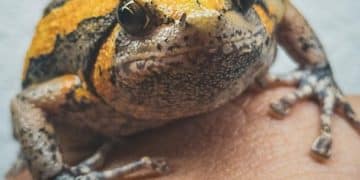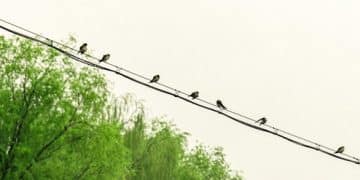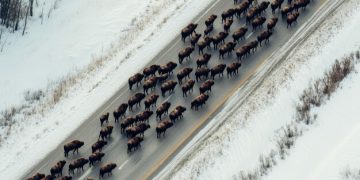Climate Change and Wildlife: How Rising Temperatures Affect US Species

The impact of climate change on wildlife in the U.S. involves significant shifts in species distribution due to rising temperatures and altered habitats, threatening biodiversity and ecosystem stability.
The **impact of climate change on wildlife: How rising temperatures are affecting species distribution in the US** is becoming increasingly evident. Rising temperatures are compelling many species to relocate, adapt, or face extinction, reshaping ecosystems across the country.
Understanding Climate Change and Its Effects
Climate change, driven by greenhouse gas emissions, is causing significant alterations to our planet’s temperature and weather patterns. These changes are not just abstract concepts; they have concrete effects on ecosystems and the wildlife that inhabit them.
The consequences of climate change extend far beyond rising sea levels and extreme weather events. They also profoundly impact the delicate balance of nature, particularly influencing where animals can survive and thrive. This article explores the escalating challenges faced by wildlife in the U.S. due to climate change.
Rising Temperatures and Habitat Loss
One of the most direct impacts of climate change is the increase in average temperatures. This warming trend is altering habitats, making them unsuitable for many species that have adapted to specific climate conditions over millennia.
As temperatures rise, habitats shift, contract, or disappear entirely. This loss of habitat forces wildlife to either adapt to new conditions, move to more suitable environments, or face decline and potential extinction.
- Altered Ecosystems: Rising temperatures directly influence ecosystems, disrupting food chains and altering species interactions.
- Invasive Species: Climate change can favor the spread of invasive species, further threatening native wildlife populations.
- Habitat Fragmentation: As habitats shrink and become fragmented, wildlife faces increased challenges in finding food, shelter, and mates.
The loss of habitat is not just a localized issue; it has far-reaching consequences for biodiversity and ecosystem stability. Protecting and restoring habitats is crucial for mitigating the impact of climate change on wildlife.
Shifts in Species Distribution
Perhaps the most visible consequence of climate change on wildlife is the shift in species distribution. As temperatures rise and habitats change, many animals are forced to move to new areas in search of suitable living conditions.
These shifts in distribution can have profound effects on ecosystems, as species interactions are disrupted and new ecological relationships are formed. Understanding these shifts is essential for effective conservation strategies.
Northward and Upward Migration
Many species are shifting their ranges northward or to higher elevations in response to rising temperatures. This phenomenon is particularly evident in mountainous regions, where animals can move upslope to find cooler climates.
However, this migration is not always possible. Geographic barriers, such as urban development or agricultural land, can prevent species from reaching suitable habitats, leading to population declines.
- Range Contraction: As species move to higher elevations, their ranges contract, leading to increased competition for resources.
- Ecological Imbalance: Shifts in species distribution can disrupt ecological relationships, leading to imbalances in ecosystems.
- Increased Competition: Migrating species may face increased competition with native species for resources.
The ability of species to shift their distribution in response to climate change depends on a variety of factors, including their dispersal ability, habitat availability, and the presence of barriers to movement. Conservation efforts must consider these factors to effectively protect wildlife in a changing climate.
Impact on Specific Species
The effects of climate change are not uniform across all species. Some animals are more vulnerable than others due to their specific habitat requirements, limited dispersal abilities, or sensitivity to temperature changes.
Examining the impact on specific species provides valuable insights into the broader consequences of climate change on wildlife. Understanding these vulnerabilities is critical for developing targeted conservation strategies.
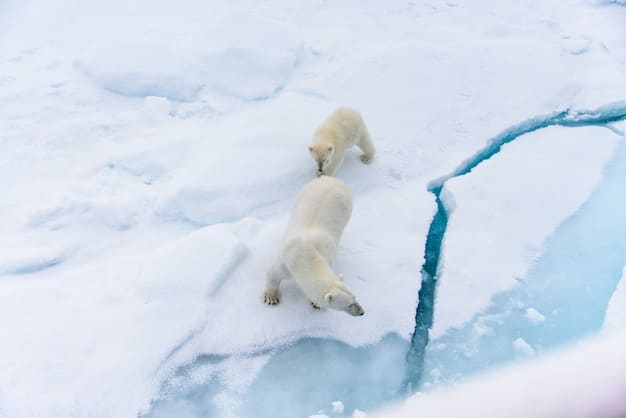
Polar Bears and Arctic Wildlife
Polar bears, iconic symbols of the Arctic, are among the most threatened species by climate change. The shrinking sea ice, their primary hunting platform, is forcing them to spend more time on land, making it difficult to find food.
Other Arctic species, such as seals and walruses, are also facing significant challenges due to the loss of sea ice. These changes are disrupting the entire Arctic ecosystem, with far-reaching consequences.
- Reduced Hunting Success: Polar bears are struggling to hunt seals, their primary prey, due to the lack of sea ice.
- Increased Starvation: Many polar bears are experiencing starvation, leading to population declines.
- Habitat Degradation: The melting of permafrost is also affecting Arctic ecosystems, leading to further habitat degradation.
The plight of polar bears serves as a stark reminder of the devastating impact of climate change on vulnerable species. Protecting Arctic ecosystems and reducing greenhouse gas emissions are crucial for the survival of these animals.
The Role of Conservation Efforts
Conservation efforts play a critical role in mitigating the impact of climate change on wildlife. By protecting and restoring habitats, reducing human-wildlife conflict, and promoting sustainable practices, we can help wildlife adapt to a changing climate.
Effective conservation strategies must be tailored to the specific challenges faced by wildlife in different regions. Collaboration between governments, organizations, and individuals is essential for successful conservation outcomes.
Habitat Preservation and Restoration
Protecting and restoring habitats provides refuge for wildlife in a changing climate. This includes conserving existing habitats, restoring degraded areas, and creating corridors to connect fragmented habitats.
By preserving and restoring habitats, we can help wildlife thrive in the face of climate change. These efforts also have broader benefits for ecosystems and human communities.
- Protected Areas: Establishing and managing protected areas is crucial for conserving biodiversity and providing refuge for wildlife.
- Habitat Corridors: Creating corridors to connect fragmented habitats allows wildlife to move between areas in search of food, shelter, and mates.
- Restoration Projects: Restoring degraded habitats can improve their suitability for wildlife and enhance ecosystem resilience.
Habitat preservation and restoration are essential components of a comprehensive conservation strategy. These efforts must be prioritized to protect wildlife in a changing climate.
Climate Change and Human Health
Climate change impacts not only wildlife but also human health. Rising temperatures, extreme weather events, and changes in species distribution can affect air and water quality, increase the spread of diseases, and disrupt food systems.
Recognizing the interconnectedness of human and environmental health is crucial for developing effective climate change solutions. By addressing climate change, we can improve both human and wildlife well-being.
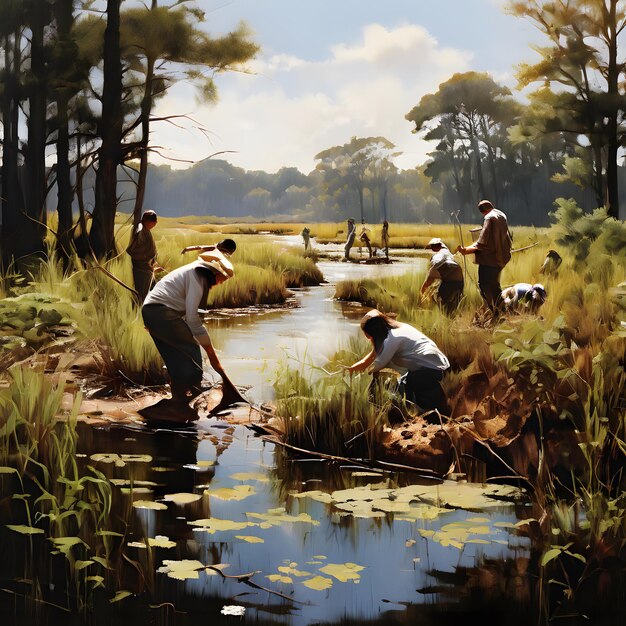
Impacts on Water Resources
Climate change is affecting water resources in many ways, including changes in precipitation patterns, increased evaporation, and reduced snowpack. These changes can lead to water shortages, affecting both human communities and wildlife.
Conserving water resources and improving water management practices are essential for ensuring a sustainable future for both people and wildlife.
- Water Scarcity: Climate change is exacerbating water scarcity in many regions, leading to increased competition for resources.
- Water Quality: Rising temperatures can affect water quality, leading to increased algae blooms and other waterborne pollutants.
- Ecosystem Health: Changes in water availability can disrupt ecosystems, affecting fish populations and other aquatic wildlife.
Addressing the impacts of climate change on water resources requires a multi-faceted approach, including reducing greenhouse gas emissions, conserving water, and improving water management practices. These efforts are essential for protecting both human and environmental health.
Taking Action
Addressing the **impact of climate change on wildlife** requires a collective effort. Individuals, communities, governments, and organizations all have a role to play in reducing greenhouse gas emissions, protecting and restoring habitats, and promoting sustainable practices.
By taking action, we can help wildlife adapt to a changing climate and ensure a sustainable future for all. Small changes in our daily lives, combined with larger policy changes, can make a significant difference.
Individual Actions
Individuals can take many steps to reduce their carbon footprint and support climate change solutions. These include reducing energy consumption, using sustainable transportation, and supporting local and sustainable businesses.
By making conscious choices in our daily lives, we can collectively reduce our impact on the environment and help protect wildlife from the **impact of climate change**.
- Reduce Energy Consumption: Conserve energy by turning off lights, using energy-efficient appliances, and reducing heating and cooling use.
- Sustainable Transportation: Choose sustainable transportation options, such as walking, biking, or using public transportation.
- Support Local Businesses: Support local and sustainable businesses that prioritize environmental stewardship.
Every action, no matter how small, contributes to a larger effort to address climate change. By taking individual responsibility, we can create a more sustainable future for wildlife and human communities.
| Key Area | Brief Impact |
|---|---|
| 🌡️ Rising Temperatures | Habitat loss and species migration. |
| 🌊 Shifting Habitats | Species forced to relocate or adapt. |
| 🐻 Arctic Wildlife | Threatened by loss of sea ice. |
| 🌱 Conservation | Efforts to protect and restore habitats. |
Frequently Asked Questions
▼
Climate change alters habitats by increasing temperatures and changing precipitation patterns, making them unsuitable for many species. This forces wildlife to relocate or adapt.
▼
The main threats to Arctic wildlife include the loss of sea ice, which is essential for hunting, and the melting of permafrost, which degrades habitats and disrupts ecosystems.
▼
Conservation efforts can help by protecting and restoring habitats, reducing human-wildlife conflict, and promoting sustainable practices. These efforts allow wildlife to adapt to a changing climate.
▼
Individuals can reduce their carbon footprint by conserving energy, using sustainable transportation, and supporting local and sustainable businesses. These actions contribute to broader efforts.
▼
Addressing climate change can improve human health by reducing air and water pollution, preventing the spread of diseases, and ensuring a sustainable food supply. It benefits both humans and wildlife.
Conclusion
The **impact of climate change on wildlife** is a multifaceted issue that demands immediate attention and concerted action. By understanding the challenges, implementing effective conservation strategies, and promoting sustainable practices, we can help wildlife adapt to a changing climate and ensure a sustainable future for all.

